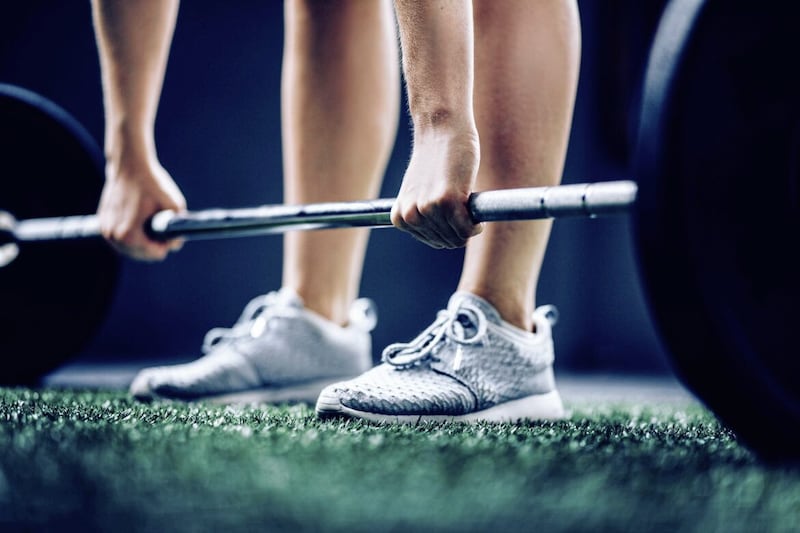OVER the past few years, HIIT has become one of the most popular ways to break a sweat, thanks to its quick and effective methods that promise the best results in minimal time.
But recently, a change has been happening in the fitness industry. Rather than focusing on how many calories you can burn in one time-crunched HIIT class, a new school of thinking suggests slowing things down with weight-bearing training sessions could actually bring more gains in the long run.
According to many personal trainers, if you're looking to drop a few pounds, sculpt rock-hard abs and feel all-round fit and healthy, you'll get more sustainable results by picking up a barbell or dumbell than just repping through rounds of burpees and crunches.
We asked top trainers to explain how strength training can help you get into the best shape of your life, and why you don't need to worry about 'bulking up' during the process...
:: What's the difference between cardio and strength training?
"Cardio is basically any exercise that challenges your circulatory system, increases your heart rate and builds your aerobic capacity," says Kate l'Anson, trainer at Digme Fitness (digmefitness.com).
Good examples of cardio include running, cycling and jumping exercises, and l'Anson explains that HIIT is basically a more intense version of these movements.
Strength training, meanwhile, uses resistance to load and overload muscle tissue, forcing it to rebuild stronger. Whether you sweat for an hour a week or an hour a day, the way you work out can affect the progress you make over time, and seeing results isn't always as simple as finding the first video tutorial that pops up on YouTube.
"Cardio and strength training are very separate physiological processes," explains personal trainer and sports scientist Luke Worthington (@lukewtraining).
"Strength work, such as lifting weights, trains your musculoskeletal system to be able to produce and withstand more force, while cardiovascular training is conditioning the heart and lungs to be more effective at transporting oxygen around the body."
Worthington says that while both are important for health and wellbeing, he believes strength training is the foundation of any fitness programme. "I often describe it to clients as the cup within which all the aspects of health and fitness sit."
:: What are the benefits of strength training?
It's a myth that lifting weights will solely build bulk like Arnold Schwarzenegger – l'Anson says regular resistance training can help you build lean, non-bulky muscle. It's a good idea to start in your 20s, she adds, as it helps prevent the natural lean muscle mass loss that comes with ageing later in life.
"It also improves your bone density," she continues. "This is particularly important for women, as it reduces the risk of osteoporosis and other bone degenerative diseases."
When it comes to weight loss, you might burn more calories during a 5K run around your local park than you would lifting weights in the same amount of time, but your total caloric burn from a strength session will be much higher. This is because of a process called 'excess post-exercise oxygen consumption' or EPOC.
"Strength training leads to increased muscle mass, which has a positive effect on weight loss," says l'Anson. "The more lean muscle mass you have, the higher your resting metabolism will be, and the more calories you burn going about your day-to-day life, after your training session has finished."
Strength training also helps you develop better body mechanics as it improves balance, coordination, posture and strength through mobility. Cross-training all of these elements can benefit you in other kinds of sports too, whether you like to run, box, dance, swim or cycle, helping improve performance and reduce injuries.
Plus, there are mental health benefits. "Setting and achieving tangible goals is a tried and tested method for improving wellbeing and satisfaction," says Worthington.
"Training for strength allows us to do exactly that, so whether it's working towards your first pull-up or press-up or something more advanced such as a deadlift personal best, hitting your goals can feel amazing."
:: Why can your progress plateau with cardio?
"It's not limited to cardio and HIIT, but with any exercise, the body adapts to a stimulus over time," says L'Anson. She explains that once your body is used to your regular cardio workouts, you may find your progress starts to hit a wall.
"The good thing about strength training is that you're always increasing the weight placed on your body. This means you're constantly demanding gains in muscle size, strength and endurance, which is key to any kind of training to avoid the plateau."
:: What should people know before trying strength training at home?
If you're thinking about purchasing a set of weights, form is key. "It's important to have correct technique instruction, not just for safety but because form dictates function – performing an exercise in a different manner to the one which was intended will create very different result," says Worthington.
You might want to think about your diet too. "Consuming adequate protein to stimulate muscle growth and rebuild is fundamental to the process," says l'Anson.
As a general guide, Worthington says 1.5-2g of protein per kilogram of body weight is a good guide for optimising body composition, so a 65kg woman or an 85kg man would require up to 130g or 170g of protein per day. Meat, poultry, fish, eggs, grains and nuts are all good sources of protein, or you could try whizzing up some protein powder in your shakes.
Worthington says a misconception is that people need to be 'fit enough' to start to work with a trainer or coach, and so often will either train alone or in group classes to start off with – thinking they need to 'graduate' onto strength training later.
"The most effective approach is actually to do the opposite. Engage with a trainer as early as possible to learn the good foundations of the fundamental strength movements," he says. "Then once you have mastered the form, think about doing the movements faster in a HIIT class environment. It's much easier to learn good habits than unlearn bad ones."








